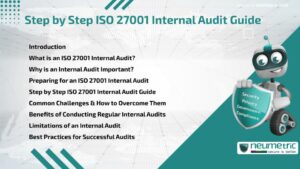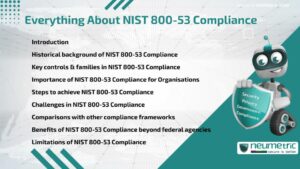Table of Contents
ToggleIntroduction
NIST 800-53 Compliance refers to following the security & Privacy controls outlined in the National Institute of Standards & Technology [NIST] Special Publication 800-53. These controls are designed to secure Federal Information Systems & critical infrastructures. Organisations outside of Government, including private businesses & non-profits, often adopt the Framework to improve resilience. In this article, we will explore the history of NIST 800-53 Compliance, its key control families, why it matters for Organisations, common challenges, comparisons with other frameworks & its broader benefits.
Historical background of NIST 800-53 Compliance
The origins of NIST 800-53 Compliance date back to the Federal Information Security Management Act [FISMA] of 2002, which tasked NIST with developing security standards. Over time, the Framework evolved through multiple revisions to address emerging Threats like ransomware, Cloud Security & Privacy Risks. Each update added more practical safeguards, making it one of the most widely respected Cybersecurity guides. You can learn more about the background of FISMA & NIST standards at NIST’s official website.
Key controls & families in NIST 800-53 Compliance
The Framework organizes security & Privacy requirements into families, such as Access Control, Incident Response & Risk Assessment. These families are like different rooms in a house, each serving a unique function but collectively securing the entire structure. For example, Access Control ensures only authorized individuals can enter, while Incident Response guides Organisations on how to act during a breach. The full catalog of families can be explored through the NIST SP 800-53 controls catalog.
Importance of NIST 800-53 Compliance for Organisations
NIST 800-53 Compliance is vital because it sets a baseline for security. For federal agencies, compliance is mandatory, but many private Organisations voluntarily adopt it to strengthen defenses, meet industry requirements & build Customer Trust. Following the controls helps prevent breaches, protects Sensitive Information & ensures regulatory alignment. More details on its importance are available at the Cybersecurity & Infrastructure Security Agency (CISA).
Steps to achieve NIST 800-53 Compliance
Achieving compliance is not a one-time effort but a structured process:
- Conduct a system security plan [SSP] to document controls.
- Perform a Risk Assessment to identify Vulnerabilities.
- Implement Security Controls according to the Framework.
- Monitor systems continuously & update when new Risks emerge.
This process is much like maintaining a car: you cannot just buy it & ignore upkeep. Regular check-ups, oil changes & repairs keep it safe on the road. Similarly, regular monitoring ensures continued compliance. Guidance on implementation can be found at NIST’s Risk Management Framework page.
Challenges in NIST 800-53 Compliance
While comprehensive, NIST 800-53 Compliance is not without challenges. Its catalog is extensive & can be overwhelming for smaller Organisations with limited staff or resources. Continuous Monitoring & documentation require significant effort. Some Organisations also face difficulties mapping existing Security Measures to specific NIST controls. A good resource for overcoming these challenges is the Federal Risk & Authorization Management Program (FedRAMP).
Comparisons with other compliance frameworks
NIST 800-53 Compliance is often compared to other frameworks like ISO 27001, SOC 2 & CIS Controls. While all aim to enhance Cybersecurity, NIST 800-53 is broader & more detailed. For instance, ISO 27001 emphasizes Risk Management, while SOC 2 focuses on trust principles. NIST 800-53, on the other hand, provides a comprehensive checklist of technical & administrative safeguards. This makes it particularly valuable for Organisations seeking detailed, actionable steps.
Benefits of NIST 800-53 Compliance beyond federal agencies
Even though designed for federal use, many private companies adopt NIST 800-53 Compliance voluntarily. Benefits include stronger Data Protection, smoother vendor audits, improved Risk posture & enhanced reputation. By implementing it, businesses gain a competitive advantage, showing Clients & Partners that they take security seriously.
Limitations of NIST 800-53 Compliance
Despite its strengths, NIST 800-53 Compliance has limitations. It can be resource-heavy & difficult to implement without dedicated staff. It also does not guarantee complete protection from every Cyber Threat. Like wearing a seatbelt, it reduces Risk but does not eliminate danger. Organisations must still invest in Employee Training, awareness & advanced security tools.
Conclusion
NIST 800-53 Compliance stands as one of the most detailed & respected Cybersecurity frameworks. It provides structured controls to secure sensitive systems, protect data & support compliance with federal laws. While challenging to implement, its benefits for security & trust outweigh the obstacles.
Takeaways
- NIST 800-53 Compliance is rooted in FISMA & NIST standards.
- It organizes controls into families covering different aspects of security.
- Compliance is mandatory for federal agencies but valuable for private firms too.
- Achieving compliance requires planning, Risk Assessment, implementation & monitoring.
- While resource-intensive, it strengthens organizational resilience.
FAQ
What is NIST 800-53 Compliance?
It is adherence to the security & Privacy controls defined in NIST Special Publication 800-53.
Who must follow NIST 800-53 Compliance?
Federal agencies must comply, while private Organisations may adopt it voluntarily.
How is NIST 800-53 Compliance different from ISO 27001?
ISO 27001 is a management standard, while NIST 800-53 provides a detailed catalog of controls.
Is NIST 800-53 Compliance mandatory for private companies?
No, it is not mandatory, but many adopt it to improve Cybersecurity & meet partner expectations.
What are the main families of controls in NIST 800-53 Compliance?
They include Access Control, Incident Response, Risk Assessment, system integrity & more.
How often should Organisations update compliance?
Organisations should monitor continuously & update controls whenever new Risks or changes occur.
Does NIST 800-53 Compliance guarantee complete security?
No, it reduces Risks significantly but does not eliminate all Cyber Threats.
Need help for Security, Privacy, Governance & VAPT?
Neumetric provides organisations the necessary help to achieve their Cybersecurity, Compliance, Governance, Privacy, Certifications & Pentesting needs.
Organisations & Businesses, specifically those which provide SaaS & AI Solutions in the Fintech, BFSI & other regulated sectors, usually need a Cybersecurity Partner for meeting & maintaining the ongoing Security & Privacy needs & requirements of their Enterprise Clients & Privacy conscious Customers.
SOC 2, ISO 27001, ISO 42001, NIST, HIPAA, HECVAT, EU GDPR are some of the Frameworks that are served by Fusion – a SaaS, multimodular, multitenant, centralised, automated, Cybersecurity & Compliance Management system.
Neumetric also provides Expert Services for technical security which covers VAPT for Web Applications, APIs, iOS & Android Mobile Apps, Security Testing for AWS & other Cloud Environments & Cloud Infrastructure & other similar scopes.
Reach out to us by Email or filling out the Contact Form…





